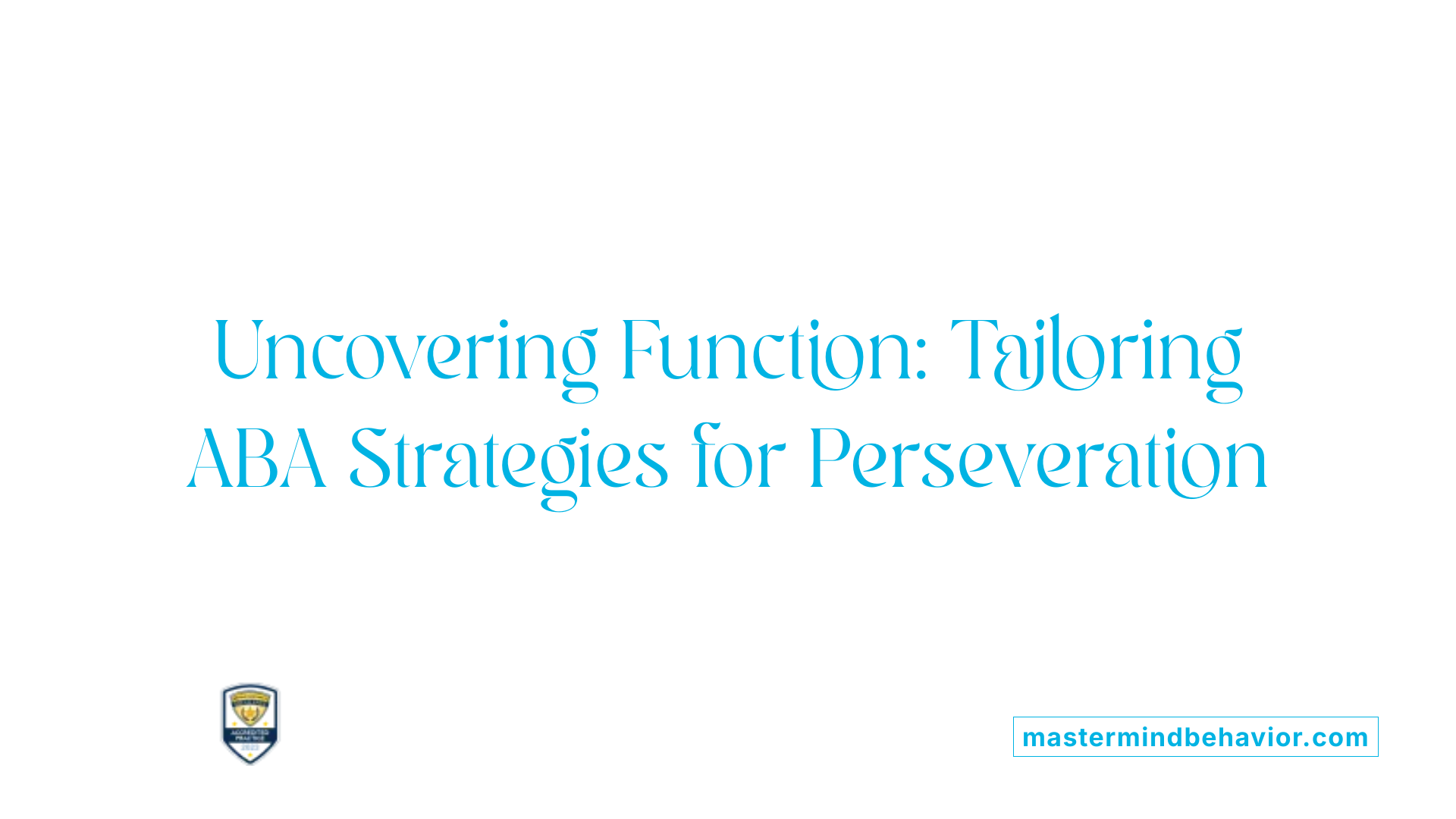The Role Of ABA Therapy In Managing Perseverative Behaviors

Introduction to Perseverative Behaviors and ABA Therapy
Perseverative behaviors, including repetitive speech, fixations, and routines, are common among individuals with autism spectrum disorder (ASD) and related conditions. These behaviors can serve various functions—such as seeking attention, coping with anxiety, or maintaining a sense of predictability—making their management complex. Applied Behavior Analysis (ABA) offers a scientifically grounded, personalized approach to understanding and reducing these behaviors, ultimately supporting greater adaptive functioning and social integration.
The Foundations of ABA Therapy and Its Focus on Behavior Modification

Principles of ABA
Applied Behavior Analysis (ABA) is grounded in the science of learning and behavior. It uses proven techniques to understand how behaviors are learned and maintained, allowing therapists to modify behaviors through systematic methods. ABA relies on simple, observable units: antecedents (what happens before a behavior), behaviors themselves, and consequences (what happens after the behavior).
Science of learning and behavior
ABA is based on research showing that behaviors can be increased or decreased through specific strategies. Techniques like positive reinforcement, where helpful behaviors are rewarded, are central to ABA. This approach ensures that individuals are encouraged to develop new, more functional skills while reducing problematic behaviors.
Goals of ABA in reducing harmful behaviors
One primary aim of ABA is to decrease behaviors that interfere with learning or daily functioning, such as perseverative speech or fixations. Therapists use functional behavior assessments to understand the purpose behind these behaviors—whether they seek attention, occur because of anxiety, or serve other functions. By identifying these reasons, tailored strategies are developed to effectively replace harmful behaviors with more appropriate responses.
ABA isn't a one-size-fits-all method. It involves customizing interventions, such as visual cues or structured routines, to meet each individual’s unique needs. When properly applied, ABA helps enhance communication, social skills, and daily living abilities while reducing unwanted perseverative behaviors.
| Concept | Explanation | Application Example |
|---|---|---|
| Principles | Based on learning science | Reinforcement to increase positive behaviors |
| Techniques | Strategies like positive reinforcement, visual supports, and environmental modifications | Teaching alternative ways to gain attention instead of perseverating |
| Goals | Improve communication, reduce harmful behaviors, build adaptive skills | Using social stories to manage anxiety or repetitive actions |
In essence, ABA therapy serves as a scientifically supported approach that directly targets behaviors, making it an essential part of treatment plans for individuals exhibiting perseverative tendencies.
Strategies and Techniques Employed in ABA to Target Perseveration

What interventions and techniques are used in ABA to manage perseveration?
Applied Behavior Analysis (ABA) employs a variety of targeted strategies to address perseverative behaviors, which are common in individuals with autism spectrum disorder (ASD) and related conditions. One fundamental approach involves reinforcement strategies that promote flexible, adaptive responses, replacing rigid and repetitive behaviors.
Differential reinforcement is frequently used to encourage alternative, more functional behaviors. For example, a therapist may reinforce a child's effort to shift attention to a new activity, rather than fixate on a specific object or topic. This can help the individual develop more adaptive ways of managing their focus.
A crucial component of ABA is conducting a functional analysis through the ABC model—antecedent, behavior, and consequence. This approach helps identify what reinforces perseverative actions, such as gaining social attention or reducing anxiety. Once the maintenance function is understood, interventions such as noncontingent reinforcement (NCR) can be applied. NCR involves providing reinforcement independent of behavior, which diminishes the motivation to engage in perseveration by fulfilling the reinforcing need in a different way.
In combination, NCR and extinction procedures are effective in reducing perseverative behaviors over the long term. Extinction involves withholding reinforcement following perseverative responses, discouraging the behavior. Visual supports like schedules and cues play a vital role in these strategies, providing predictability and structure that can reduce anxiety-linked perseveration.
Behavioral interventions also incorporate techniques such as ignoring perseverative speech or actions when they serve a self-stimulatory or attention-seeking function. Redirecting attention to more appropriate activities or using visual aids to prompt alternative behaviors help individuals gain skills in self-regulation.
Comprehensive, multidisciplinary approaches that include modifications to the environment, sensory regulation techniques, and behavioral strategies tend to be most effective. Tailoring interventions based on individual assessments ensures that strategies address the specific functions of perseveration, whether it stems from seeking attention, anxiety, or other reasons.
Overall, ABA's flexibility allows for the integration of these techniques into personalized plans that promote social communication, reduce problematic perseverative behaviors, and support developmental progress.
Understanding the Function of Perseverative Behaviors and Tailoring Interventions Accordingly

What is the purpose of perseverative behaviors?
Perseverative behaviors, such as repetitive speech, fixation on specific items, or engaging in particular routines, commonly occur in individuals with autism spectrum disorder (ASD). These behaviors can serve various functions, including gaining attention, reinforcing personal interest, or helping manage anxiety. Recognizing the purpose behind these behaviors is crucial for developing effective intervention strategies.
How do social and automatic reinforcements influence perseveration?
Perseverative behaviors may be maintained by different types of reinforcement. Social reinforcement occurs when behaviors attract attention, praise, or interaction from others. For example, a child might repeat a phrase to get a caregiver’s response. Automatic reinforcement happens when the behavior itself provides sensory satisfaction or relief from discomfort, such as finger-flapping or excessive hair pulling.
Understanding whether a behavior is maintained by social or automatic reinforcement helps clinicians tailor interventions. If a behavior is social reinforcement-based, strategies might include teaching alternative ways to seek attention. If automatic, sensory-based, other forms of intervention may be more effective.
What role does functional behavior assessment play?
A functional behavior assessment (FBA) is an essential tool in identifying the reasons behind perseverative behaviors. It involves observing and analyzing the context in which behaviors occur, the antecedents triggering them, and the consequences that reinforce them.
The FBA helps pinpoint whether the behavior is primarily a response to anxiety, a means of obtaining attention, or an automatic self-stimulatory activity. This understanding guides the development of individualized strategies that target the root cause of the perseveration.
How does individualized intervention planning work?
Interventions based on FBA findings are highly tailored to each individual's needs. For behaviors driven by attention-seeking, techniques like introducing visual cues, not engaging in response to the perseverative behavior, and teaching alternative ways to get attention are effective.
When behaviors serve to reduce anxiety or provide sensory relief, strategies may include creating predictable routines, providing calming sensory activities, and introducing visual aids for redirection.
A comprehensive approach combines structured routines, visual supports, environmental modifications, and positive reinforcement. These interventions are designed to reduce perseverative behaviors while promoting flexible, functional behaviors.
How does ABA therapy incorporate these strategies?
Applied Behavior Analysis (ABA) applies these principles by systematically analyzing behaviors and their functions. ABA interventions often include functional analysis to identify behavior functions, then employ targeted strategies such as noncontingent reinforcement (NCR), extinction, and environmental modifications.
ABA programs are flexible and adaptable, designed by qualified behavior analysts to meet individual needs. They focus on promoting social, communication, and adaptive skills while reducing problematic perseveration.
Through consistent and tailored application, ABA helps children develop more adaptive behaviors, improve cognitive flexibility, and enhance overall functioning, making it a well-supported, evidence-based approach for managing perseverative behaviors in autism.
Evidence Supporting the Effectiveness of ABA in Reducing Perseverative Behaviors

How effective are ABA strategies in managing perseverative behaviors?
Research shows that ABA methods are highly effective in decreasing perseverative behaviors such as repetitive speech or fixation on objects. When clinicians identify the functions behind such behaviors—whether to gain attention, alleviate anxiety, or access tangible items—they can implement targeted interventions.
Strategies like noncontingent reinforcement (NCR), extinction, differential reinforcement of alternative behaviors (DRA), and prompting have proven particularly successful. Studies have reported reductions in perseverative behaviors by as much as 98.5%. These improvements are often maintained over time when treatment plans are personalized and include follow-up assessments.
The success of ABA hinges on a thorough understanding of why the behavior occurs. By tailoring intervention strategies to address specific social or emotional functions, practitioners can significantly diminish these behaviors, enhancing the individual's social and daily life skills.
Do long-term ABA treatments sustain improvements?
Yes, evidence indicates that intensive, extended ABA programs lead to lasting benefits. Long-term treatment has been linked with improvements in intellectual functioning, language acquisition, and executive skills. The structured nature of ABA, combined with consistent reinforcement of positive behaviors, supports sustained behavioral change.
Can real-world examples illustrate ABA success?
Certainly, numerous case studies demonstrate the positive impact of ABA on perseverative behaviors. For example, a child exhibiting compulsive hair-pulling was introduced to visual cues and alternative attention-gaining strategies, leading to a significant decrease in the behavior. These practical implementations show how functional assessments guide individualized approaches and produce meaningful results.
What measures indicate success?
Success is often measured by the reduction in frequency and intensity of perseverative behaviors, improved communication skills, and better social engagement. Data collection during interventions helps track progress and adjust strategies as needed. Studies generally report substantial behavioral improvements, bolstering the case for ABA's effectiveness.
| Aspect | Description | Evidence or Result |
|---|---|---|
| Research Outcomes | ABA reduces perseverative behaviors | Up to 98.5% decrease in some cases |
| Long-term Benefits | Improved language, social, daily living skills | Sustained progress over years |
| Practical Cases | Individualized strategies lead to success | Case studies show significant reductions |
| Success Metrics | Behavior frequency, social skills, communication | Measurable improvements in assessments |
Using well-designed ABA programs, drawn from current research and tailored to individual needs, offers a proven route to decreasing perseverative behaviors and improving overall functional skills.
The Use of Visual Supports and Structured Routines to Manage Perseverative Behaviors
 Social stories and PowerPoint presentations are valuable tools provided by the Watson Institute to support individuals with perseverative behaviors. These resources are designed to be easily downloadable and customizable, making them practical for therapists, educators, and parents who aim to implement behavior strategies effectively.
Social stories and PowerPoint presentations are valuable tools provided by the Watson Institute to support individuals with perseverative behaviors. These resources are designed to be easily downloadable and customizable, making them practical for therapists, educators, and parents who aim to implement behavior strategies effectively.
Social stories help clarify expected behaviors and guide appropriate responses by illustrating real-life scenarios. For example, a social story focusing on anxiety or hair pulling can teach individuals strategies to cope or redirect their focus.
PowerPoint presentations can serve as visual aids for teaching new skills or routines. They can illustrate step-by-step instructions for daily activities or social interactions, helping individuals understand expectations and reduce fixation on certain objects or topics.
Visual cues and schedules play a crucial role in managing perseverative behaviors. Using visual supports like pictorial schedules and cue cards provides clear structure and predictability, which can alleviate anxiety and reduce repetitive behaviors.
Structured routines and rules are also essential. Establishing predictable daily routines and setting time limits for specific activities help create a stable environment. For example, timers or tokens can be used to signal when a preferred activity should start or end, helping to control perseverative pursuits.
These tools are highly adaptable. Practitioners can modify social stories and visual supports to match each individual's needs, preferences, and behavioral functions. This customization ensures that interventions are engaging and effective.
Strategies such as scheduling specific times to discuss perseverative topics and introducing alternative activities are practical ways to redirect focus. Additionally, teaching individuals alternative ways to seek attention or express their interests, in collaboration with specialists like occupational therapists, can promote better emotional regulation.
To sum up, combining visual supports, structured routines, and customizable tools enhances the ability to manage perseverative behaviors effectively. These approaches, grounded in behavioral science, foster independence and social participation for individuals on the autism spectrum.
The Importance of Tailored, Data-Driven Interventions and the Role of Qualified Professionals
Why is ABA therapy considered important in treatment plans for perseverative behaviors?
ABA (Applied Behavior Analysis) therapy plays a crucial role in managing perseverative behaviors because it provides a scientific approach that can be customized for each individual. It focuses on understanding the reasons behind behaviors and uses this information to plan effective interventions. For example, functional analysis helps identify what maintains perseverative speech or routines, such as seeking attention or reducing anxiety.
Interventions like noncontingent reinforcement (NCR) combined with extinction have shown to significantly reduce perseverative behaviors — with some studies reporting decreases of up to 98.5%. ABA uses evidence-based techniques such as differential reinforcement, visual supports, and environmental changes to help individuals develop more adaptive behaviors. This focus on personalized, data-driven strategies makes ABA a vital part of comprehensive treatment plans for those showing perseverative tendencies.
How do qualified behavior analysts contribute to successful ABA programs?
Qualified professionals, especially Board Certified Behavior Analysts (BCBAs), are central to implementing effective ABA programs. They design plans based on detailed assessments of the individual’s strengths and needs. BCBAs continuously monitor progress by collecting and analyzing data, which helps guide decisions on modifying strategies to maximize effectiveness.
These experts tailor interventions like social stories, visual aids, and routines to better suit each person’s unique situation. They also work closely with families, teachers, and other professionals to ensure consistency across different settings. This collaborative approach helps develop flexible, functional responses in the individual, leading to longer-lasting and meaningful behavior change. Overall, the guidance of a trained BCBA ensures that interventions are scientifically grounded and adapted for optimal results.
Summary and Future Directions
ABA therapy remains a cornerstone in the management of perseverative behaviors among individuals with autism. Its evidence-based, flexible approach allows therapists to identify the specific functions of perseveration, employ targeted interventions, and adapt strategies over time to ensure meaningful behavioral improvements. As research continues to evolve, integrating new techniques such as technological supports and more sophisticated assessment tools will further enhance ABA’s efficacy. Collaboration among trained professionals, families, and individuals themselves will be crucial in tailoring interventions and fostering durable, adaptive behavioral changes, paving the way for improved quality of life and greater independence.
References
- Social Stories for Perseverative Behaviors
- Applied Behavior Analysis (ABA)
- Perseveration: What it is and How to Address It
- Functional Analysis and Noncontingent Reinforcement ...
- Functional analysis and intervention of perseverative ...
- Functional analysis and treatment of verbal perseverations ...
- Functional Analysis and Noncontingent Reinforcement ...
- Verbal Perseveration! Verbal Perseveration!
Recent articles

How ABA Therapy Encourages Creative Play And Imagination
Unleashing Creativity: The Role of ABA Therapy in Enhancing Play and Imagination

How ABA Therapy Supports Healthy Daily Transitions At Home
Bridging Challenges: ABA Therapy's Role in Smooth Home Transitions for Children with Autism

How ABA Therapist Uses Data To Adjust Behavior Plans
Data-Driven Insights: Shaping Effective ABA Behavior Plans

ABA Therapy For Teaching Responsibility In Managing Schedules
Harnessing ABA Therapy to Cultivate Schedule Management Skills in Children with Autism

What Families Should Know About ABA Therapy Ethics And Consent
Understanding the Foundations and Ethical Framework of ABA Therapy

How ABA Providers Can Help Teachable Moments Arise Throughout the Day
Creating Learning Moments Anywhere: The Role of ABA Providers in Everyday Development



